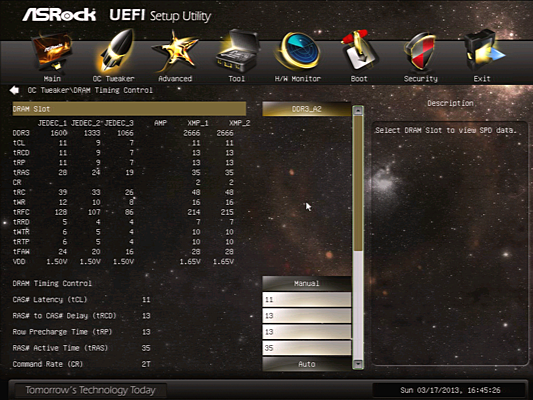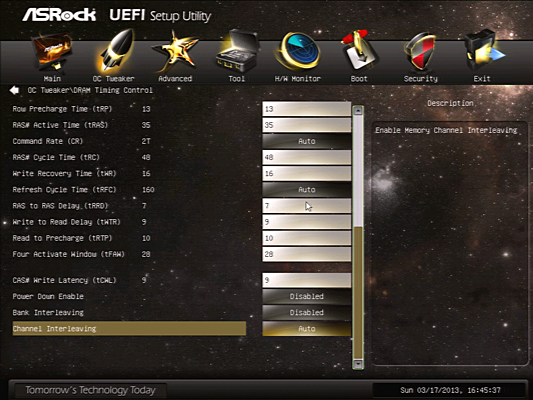Three AMD 990FX-Based Motherboards For Enthusiasts
AMD’s flagship FX-series processors squarely target enthusiasts with sub-$1,000 system budgets, and it's hard to get there with an expensive motherboard. We requested every vendor's top-value solution, and received three boards for your consideration.
990FX Extreme9 Firmware
A simple menu structure allows experienced users to custom tune their 990FX Extreme9 without jumping through unnecessary steps. As always, inexperienced users are free to seek overclocking advice within our forums.
Shown at DDR3-2424, the 990FX Extreme9 only gets our DDR3-2666 memory to 2,411 MT/s before occasional errors begin to occur. This outcome, which we'd otherwise consider mediocre, is somewhat acceptable only because the CPU’s built-in memory controller doesn’t support higher ratios. The board’s 1.635 V setting approximates our desired 1.65 volts.
The 990FX Extreme9 also pushes this AMD FX-8350 sample to 4.44 GHz at a modest 1.40 V, though with even more anomalies in the process. For example, “Load-Line Calibration” is backwards, with 100% corresponding to full droop and the minimum setting providing maximum voltage increase. Full-load core voltage fluctuated between 1.39 and 1.49 V by default, and decreasing the CPU’s maximum voltage to the desired 1.40 V was accomplished by increasing load-line compensation to 75%!
The 990FX Extreme9 supports Intel's XMP technology and retains previous latency settings when switching from automatic to manual modes. This memory, for example, has tighter SPD timings for its slower DDR3-1600 default. So, disabling the XMP profile from the main page before picking manual timing controls would have caused those tighter defaults to be reflected in the firmware’s manual configuration boxes.
Anyone who doesn’t want to limit CPU voltage themselves is welcome to try ASRock’s automatic overclocking profiles. These are designed around manipulation of the reference clock, rather than the FX processor's adjustable multiplier, so that they can also support multiplier-locked CPUs.
Get Tom's Hardware's best news and in-depth reviews, straight to your inbox.
Current page: 990FX Extreme9 Firmware
Prev Page 990FX Extreme9 Software Next Page Asus M5A99FX Pro R2.0-
designasaurus "if we diminished most of those power differences by not installing Asus' power management software at default settings, the company would have likely matched the performance of Gigabyte and ASRock."Reply
Don't speculate! Do the tests and add it to the article so we can see what the software packages are actually accomplishing! That's why I read your site, yeah? For hard info that I can't get myself. -
bgunner designasaurus"if we diminished most of those power differences by not installing Asus' power management software at default settings, the company would have likely matched the performance of Gigabyte and ASRock."Don't speculate! Do the tests and add it to the article so we can see what the software packages are actually accomplishing! That's why I read your site, yeah? For hard info that I can't get myself.I totally agree with this statement. The test should have been done and added into the article because this would of been a good representative of the value of the software. I would like to know for a fact if the software was a hindrance to the electrical efficiency of the Asus and Gigabye boards.Reply -
Crashman bgunnerI totally agree with this statement. The test should have been done and added into the article because this would of been a good representative of the value of the software. I would like to know for a fact if the software was a hindrance to the electrical efficiency of the Asus and Gigabye boards.At least the power was measured and mentioned, even if it didn't get into the chart.Reply
-
bit_user AMD's 890FX was an excellent low-cost server platform, in its day. Great I/O, tons of PCIe lanes, 6-channel SATA3, and ECC support. All with boards and CPUs in the desktop price range that were close to being performance competitive with Intel (when they were introduced, at least).Reply
Now, AMD is just slipping too far behind. Not just on the CPU front, but like how about some PCIe 3?
I'm waiting for 64-bit ARMs to hit the desktop. That's probably the next truly interesting thing on the horizon.
-
boulbox Reply10596062 said:Aren't the 990FX chipsets kind old?
Yes, but not a lot of new things need to be offered anyways. PCIe 3.0 is just a gimmick and doesn't really give much more performance over PCIe2 -
Crashman falchardAren't the 990FX chipsets kind old?990FX is AMD's current "high-end" chipset for enthusiast-level desktops. AMD occasionally releases new chips (look last fall) and motherboard companies keep updating their selection of products.Reply
Old chipset, recent boards, any questions?
-
darkchazz "Three AMD 990FX-Based Motherboards For Enthusiasts"Reply
I don't think enthusiasts would want to buy a slow CPU from AMD. -
Onus What did I miss? The ASRock has better features, including 3-way SLI, more USB3.0, an abundance of accessories, uses less power (the only positive efficiency), has higher performance, lower VRM temps; but BOTH of the other two got awards? I noted the comment about fluctuating prices, but on features alone ASRock looks like the winner. Surely it wasn't the slightly lower OC...Reply





